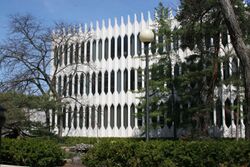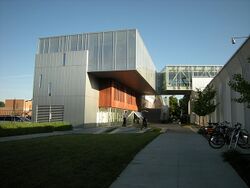Oberlin Conservatory of Music
Topic: Organization
 From HandWiki - Reading time: 6 min
From HandWiki - Reading time: 6 min
 Musician entering the Oberlin Conservatory | |
| Type | Private music conservatory |
|---|---|
| Established | 1865 |
Parent institution | Oberlin College |
| Dean | William Quillen |
Academic staff | 88 |
| Students | 615 |
| Location | Oberlin , Ohio , United States [ ⚑ ] : 41°17′29″N 82°13′10″W / 41.291402°N 82.219407°W |
| Website | http://www.oberlin.edu/conservatory |
The Oberlin Conservatory of Music is a private music conservatory in Oberlin College in Oberlin, Ohio. It was founded in 1865 and is the second oldest conservatory and oldest continually operating conservatory in the United States. It is one of the few American conservatories to be completely attached to a liberal arts college, allowing students the opportunity to pursue degrees in both music and a traditional liberal arts subject via the five year Double-Degree program. Like the rest of Oberlin College, the student body of the conservatory is almost exclusively undergraduate.
History
The Oberlin Collegiate Institute was built on 500 acres (2.0 km2) of land, founded in 1833 and became Oberlin College in 1850. In 1867, two years after the Oberlin Conservatory's founding in 1865, the previously separate Oberlin Conservatory became incorporated with the college on a similar grant.[1]
In tandem, the administration claimed that "Oberlin is peculiar in that which is good," notable as the first college and first conservatory in the United States to regularly admit African-American students. Oberlin College's role as an educator of African-American students prior to the Civil War and thereafter is historically significant.[2] Notable is the graduation of William Grant Still, a student who widely became regarded as the "dean of African-American composers." These efforts have helped Oberlin remain committed to its values of freedom, social justice, and service.[3]
It is also the oldest continuously operating coeducational conservatory, since its incorporation with Oberlin College, the first coeducational college. The college and conservatory were listed as a National Historic Landmark on December 21, 1965, for its significance in social progress.[4]
Due to the conservatory's affiliation with Elisha Gray, inventor of the electromechanical oscillator, and Thaddeus Cahill, inventor of the telharmonium, Oberlin Conservatory plays a role in the origins of electronic music. The TIMARA (Technology In Music And Related Arts) program was the world's first conservatory program in this field, established in 1967.
Oberlin Conservatory was the recipient of the 2009 National Medal of Arts, the highest award given by the United States government to artists and arts patrons in recognition of the wealth and depth of their creative expressions. The Oberlin Conservatory of Music is the only professional music school to be so honored by President Barack Obama.
Admissions
Due to the conservatory's affiliation with Oberlin College, students may either enter the conservatory only or Oberlin's five year Double-Degree program, in which the student will complete both a Bachelor of Music degree as well as a Bachelor of Arts. Admission is based primarily on an extremely competitive audition; over 1,400 musicians from around the world apply for a freshman class of around 120.
Facilities
The conservatory was previously housed in Warner Hall, a large stone building where the King Building now stands. It now occupies four interconnected buildings on the south side of Tappan Square. The original structure of three big white buildings was designed by the Japanese-American architect Minoru Yamasaki in 1963, which closely resembles Yamasaki's later design of the World Trade Center in New York City .
In 2010, The Bertram and Judith Kohl Building opened to provide a new home for the Jazz Studies, Music History, and Music Theory departments. Kohl is connected to Robertson by a third-floor enclosed bridge, which also contains the Sky Bar, named for the iconic Cleveland jazz club that closed in 1954.
The Robertson Building houses around 150 practice rooms, most with windows. In addition, the Otto B. Schoepfle Vocal Arts Center, Career Resource Center, Kulas Organ Center, reed-making rooms, computer labs, faculty studios, and staff offices are located here.
The conservatory contains the largest collection of Steinway & Sons pianos, outside of the Steinway factory, in the world.
Programs and departments
Bachelor of Music Program (BM): Oberlin Conservatory offers private study in 31 applied areas and undergraduate majors, including a double major in piano performance and vocal accompanying.[5]
- Department of Contemporary Music: Composition, Technology In Music And Related Arts (TIMARA), Jazz Studies
- Department of Performance: Vocal Performance, Instrumental Music Performance - for piano, organ, flute, clarinet, oboe, trumpet, trombone, bassoon, French horn, tuba, violin, viola, double bass, cello, harp, percussion and guitar.
- Department of Historical Performance: Historical Techniques
- Department of Musicology: Music Theory, Music History
Performance Diploma (PDip): This four-semester program, offered only in certain performance departments, is designed for the very small number of gifted performers who have not yet completed the BM or its equivalent and who are seeking a very narrowly focused program of study leading to a performance-oriented career. Performance Diploma students may apply to transfer to the Bachelor of Music program before the end of the program. Students seeking admission to the BM degree must demonstrate skills necessary to complete both the performance and academic coursework required for the BM. Students who have completed requirements for both the BM and the Performance Diploma will receive only the BM.
Master of Music in Conducting (MM): The MM in Conducting is available only as part of five-year programs integrated with an Oberlin Bachelor of Music degree with a major in Performance, Composition, or Music History.
Master of Music in Historical Performance (MM): The MM in Performance on Historical Instruments is intended for a limited number of students who have acquired skills on historical instruments and who wish to pursue practical study in performance in combination with the study of performance practice and musicology. Concentrations are offered in harpsichord, fortepiano, organ, Baroque violin, Baroque flute, recorder, Baroque cello/viola da gamba, historical keyboard instruments (harpsichord, fortepiano, and organ, combined), and historical oboes (Baroque, Classical, and other oboes). Students holding an undergraduate degree from another institution will take four semesters to complete the program. Oberlin undergraduates may audition during their junior year for a five-year program which combines the Bachelor of Music degree in a modern instrument with the MM in an historical instrument.
Master of Music in Teaching (MMT): The MMT is a fourteen-month degree program leading to teacher licensure and a master's degree in teaching. The degree is available in integration with an Oberlin Bachelor of Music degree with a major in Performance or Composition, or after completion of a Bachelor of Music degree in Performance or Composition from an institution other than Oberlin. Learn more about Master of Music Teaching
Artist Diploma (ADip): This four-semester program, offered only in certain performance departments, is intended for a limited number of exceptionally gifted performers who have completed the BM or its equivalent, who have acquired extensive musical background through institutional or private studies or through unusual performing experiences, and who wish to concentrate on private applied study without additional course requirements. Oberlin Conservatory Bachelor of Music graduates may apply to the Artist Diploma program only with the recommendation of the department and approval of the Office of Associate Deans of the Conservatory. Students who enroll in and/or complete the Artist Diploma program may not transfer to the Bachelor of Music degree program.
The Double-Degree Program: The Double-Degree Program represents combined Study in the College of Arts and Sciences and the Conservatory of Music. Students accepted to both the College of Arts and Sciences and the Conservatory of Music pursue a degree in each division. Oberlin's encouragement of such study–in conjunction with an exceptionally broad range of course options–makes Oberlin a uniquely effective environment for the study of both music and the liberal arts.
Notable people
Faculty
Alumni
See also
- List of Oberlin College and Conservatory people
See also
- Oberlin Jazz Ensemble
- List of colleges and university schools of music in the USA
References
- ↑ Fletcher, Robert Samuel. A History of Oberlin College From Its Foundation Through the Civil War. Chicago: R.R. Donnelley & Sons Company, 1943. Print.
- ↑ Constructing Black Education at Oberlin College
- ↑ African Americans at Oberlin, Then and Now The College's approach to African Americans was by no means perfect. Nonetheless, Oberlin graduates accounted for a significant percentage of African American College graduates at the end of the 19th Century.
- ↑ "National Historic Landmarks Program - Oberlin College". Archived from the original on 17 October 2007. https://web.archive.org/web/20071017184121/http://tps.cr.nps.gov/nhl/detail.cfm?ResourceId=450&ResourceType=Site. Retrieved 8 May 2007.
- ↑ "Degrees and Departments". Oberlin Conservatory. https://new.oberlin.edu/conservatory/degrees-and-majors/. Retrieved 9 September 2013.
External links
- Official website
- Conservatory of Music on Oberwiki
- Oberlin College Archives, see Record Group 10 for Conservatory-specific material
- Oberlin Woodwind Ensemble with director George E. Waln, circa 1948-51 (photo)
- Art of the States: Oberlin Contemporary Music Ensemble live and studio performances from the Oberlin Conservatory
 KSF
KSF



